翻译技巧重复法
- 格式:ppt
- 大小:1.38 MB
- 文档页数:15
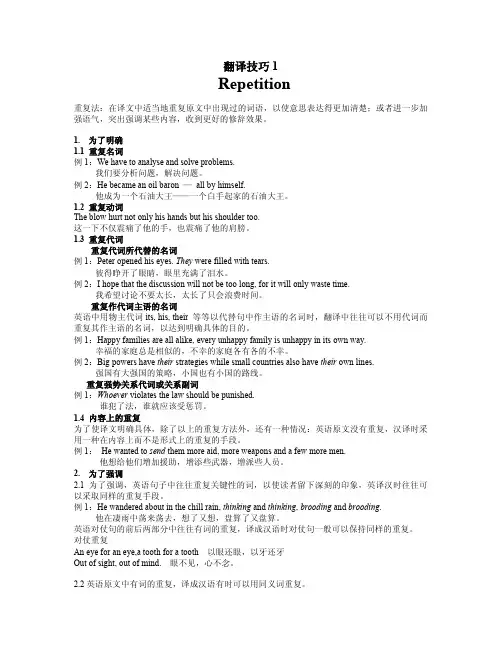
翻译技巧1Repetition重复法:在译文中适当地重复原文中出现过的词语,以使意思表达得更加清楚;或者进一步加强语气,突出强调某些内容,收到更好的修辞效果。
1.为了明确1.1重复名词例1:We have to analyse and solve problems.我们要分析问题,解决问题。
例2:He became an oil baron—all by himself.他成为一个石油大王——一个白手起家的石油大王。
1.2重复动词The blow hurt not only his hands but his shoulder too.这一下不仅震痛了他的手,也震痛了他的肩膀。
1.3重复代词重复代词所代替的名词例1:Peter opened his eyes.They were filled with tears.彼得睁开了眼睛,眼里充满了泪水。
例2:I hope that the discussion will not be too long,for it will only waste time.我希望讨论不要太长,太长了只会浪费时间。
重复作代词主语的名词英语中用物主代词its,his,their等等以代替句中作主语的名词时,翻译中往往可以不用代词而重复其作主语的名词,以达到明确具体的目的。
例1:Happy families are all alike,every unhappy family is unhappy in its own way.幸福的家庭总是相似的,不幸的家庭各有各的不幸。
例2:Big powers have their strategies while small countries also have their own lines.强国有大强国的策略,小国也有小国的路线。
重复强势关系代词或关系副词例1:Whoever violates the law should be punished.谁犯了法,谁就应该受惩罚。
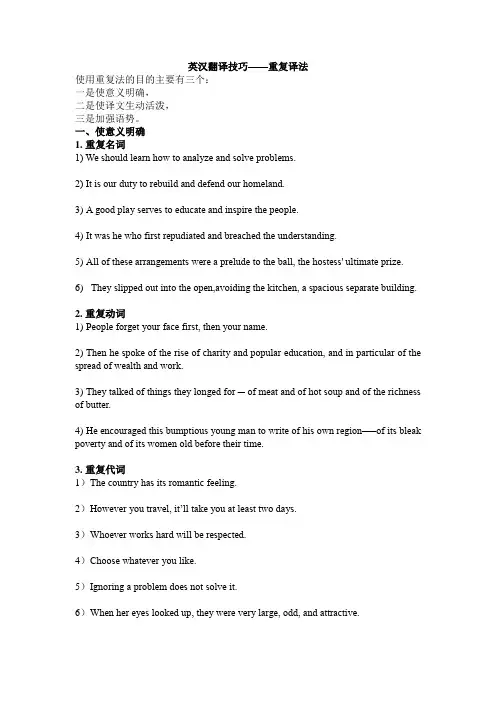
英汉翻译技巧——重复译法使用重复法的目的主要有三个:一是使意义明确,二是使译文生动活泼,三是加强语势。
一、使意义明确1.重复名词1) We should learn how to analyze and solve problems.2) It is our duty to rebuild and defend our homeland.3)A good play serves to educate and inspire the people.4)It was he who first repudiated and breached the understanding.5)All of these arrangements were a prelude to the ball, the hostess' ultimate prize.6)They slipped out into the open,avoiding the kitchen, a spacious separate building.2.重复动词1)People forget your face first, then your name.2)Then he spoke of the rise of charity and popular education, and in particular of the spread of wealth and work.3)They talked of things they longed for ─ of meat and of hot soup and of the richness of butter.4)He encouraged this bumptious young ma n to write of his own region──of its bleak poverty and of its women old before their time.3.重复代词1)The country has its romantic feeling.2)However you travel, it’ll take you at least two days.3)Whoever works hard will be respected.4)Choose whatever you like.5)Ignoring a problem does not solve it.6)When her eyes looked up, they were very large, odd, and attractive.二、使译文生动活泼1)grotesque2)careless3)in chaos4)street gossip5)rumors6) Talking and laughing, running and jumping, the children had a good time at sea-side.7) But at that time, she was the only woman there.8) His folks ate up everything he had.三、加强语势1) Would you please please please please please please please stop talking.2)Any my poor fool is hanged. No, no, no life.。
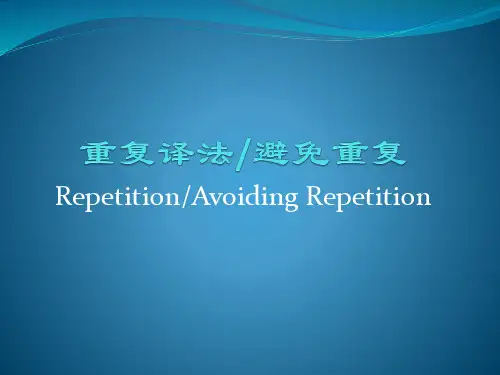
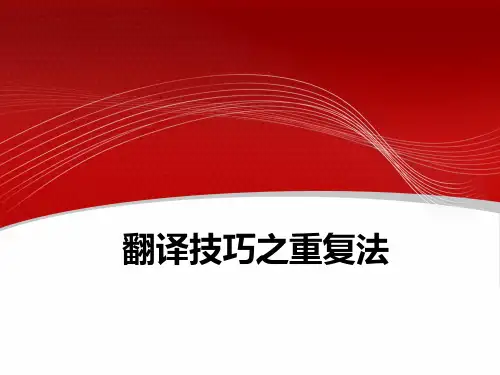
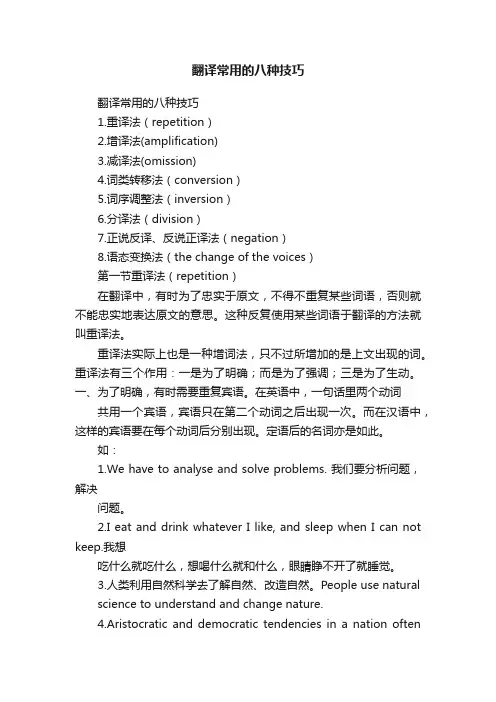
翻译常用的八种技巧翻译常用的八种技巧1.重译法(repetition)2.增译法(amplification)3.减译法(omission)4.词类转移法(conversion)5.词序调整法(inversion)6.分译法(division)7.正说反译、反说正译法(negation)8.语态变换法(the change of the voices)第一节重译法(repetition)在翻译中,有时为了忠实于原文,不得不重复某些词语,否则就不能忠实地表达原文的意思。
这种反复使用某些词语于翻译的方法就叫重译法。
重译法实际上也是一种增词法,只不过所增加的是上文出现的词。
重译法有三个作用:一是为了明确;而是为了强调;三是为了生动。
一、为了明确,有时需要重复宾语。
在英语中,一句话里两个动词共用一个宾语,宾语只在第二个动词之后出现一次。
而在汉语中,这样的宾语要在每个动词后分别出现。
定语后的名词亦是如此。
如:1.We have to analyse and solve problems. 我们要分析问题,解决问题。
2.I eat and drink whatever I like, and sleep when I can not keep.我想吃什么就吃什么,想喝什么就和什么,眼睛睁不开了就睡觉。
3.人类利用自然科学去了解自然、改造自然。
People use naturalscience to understand and change nature.4.Aristocratic and democratic tendencies in a nation oftenshowthemselves in its speech.民族的贵族倾向和民族倾向常在其言语中表现出来。
5.我们来修改安全规则和卫生规则吧。
Let’s revise our safety andsanitary regulations.二、英语常用省略,但为了明确,也为了强调某些内容,在汉语中常常要将省去的部分重译出来。
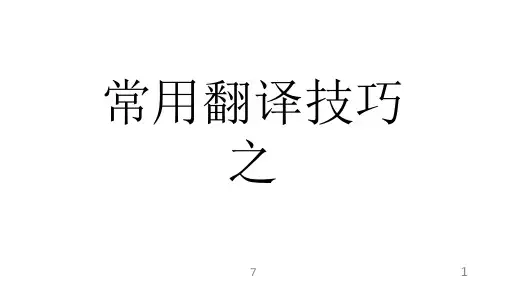
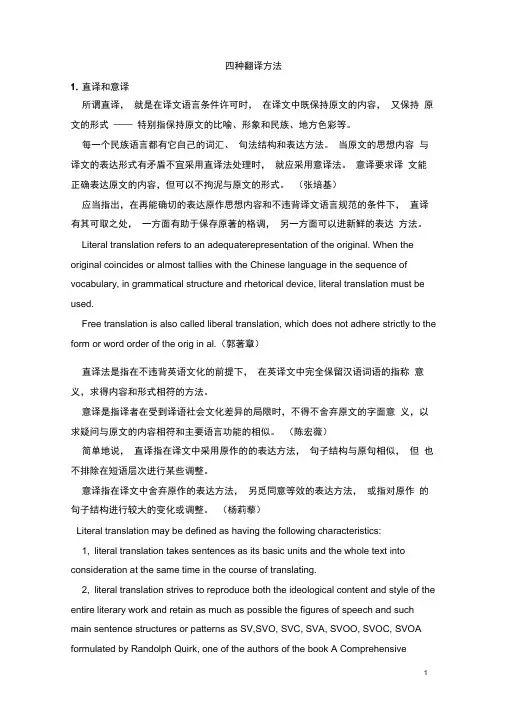
四种翻译方法1.直译和意译所谓直译,就是在译文语言条件许可时,在译文中既保持原文的内容,又保持原文的形式——特别指保持原文的比喻、形象和民族、地方色彩等。
每一个民族语言都有它自己的词汇、句法结构和表达方法。
当原文的思想内容与译文的表达形式有矛盾不宜采用直译法处理时,就应采用意译法。
意译要求译文能正确表达原文的内容,但可以不拘泥与原文的形式。
(张培基)应当指出,在再能确切的表达原作思想内容和不违背译文语言规范的条件下,直译有其可取之处,一方面有助于保存原著的格调,另一方面可以进新鲜的表达方法。
Literal translation refers to an adequaterepresentation of the original. When the original coincides or almost tallies with the Chinese language in the sequence of vocabulary, in grammatical structure and rhetorical device, literal translation must be used.Free translation is also called liberal translation, which does not adhere strictly to the form or word order of the orig in al.(郭著章)直译法是指在不违背英语文化的前提下,在英译文中完全保留汉语词语的指称意义,求得内容和形式相符的方法。
意译是指译者在受到译语社会文化差异的局限时,不得不舍弃原文的字面意义,以求疑问与原文的内容相符和主要语言功能的相似。
(陈宏薇)简单地说,直译指在译文中采用原作的的表达方法,句子结构与原句相似,但也不排除在短语层次进行某些调整。
意译指在译文中舍弃原作的表达方法,另觅同意等效的表达方法,或指对原作的句子结构进行较大的变化或调整。
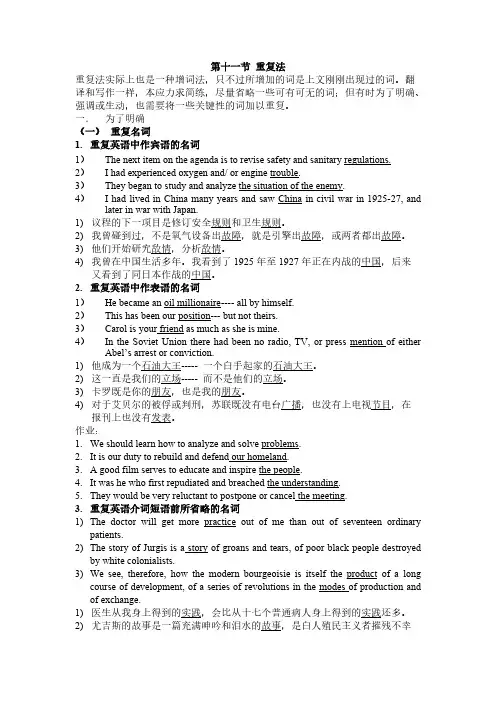
第十一节重复法重复法实际上也是一种增词法,只不过所增加的词是上文刚刚出现过的词。
翻译和写作一样,本应力求简练,尽量省略一些可有可无的词;但有时为了明确、强调或生动,也需要将一些关键性的词加以重复。
一.为了明确(一)重复名词1.重复英语中作宾语的名词1)The next item on the agenda is to revise safety and sanitary regulations.2)I had experienced oxygen and/ or engine trouble.3)They began to study and analyze the situation of the enemy.4)I had lived in China many years and saw China in civil war in 1925-27, and later in war with Japan.1)议程的下一项目是修订安全规则和卫生规则。
2)我曾碰到过,不是氧气设备出故障,就是引擎出故障,或两者都出故障。
3)他们开始研究敌情,分析敌情。
4)我曾在中国生活多年。
我看到了1925年至1927年正在内战的中国,后来又看到了同日本作战的中国。
2.重复英语中作表语的名词1)He became an oil millionaire---- all by himself.2)This has been our position--- but not theirs.3)Carol is your friend as much as she is mine.4)In the Soviet Union there had been no radio, TV, or press mention of either Abel’s arrest or conviction.1)他成为一个石油大王----- 一个白手起家的石油大王。

1.重译法(Repetition):为了忠实表达原文的意思,重复某些关键词。
作用:明确;强调;生动。
2. 增译法(Amplification)和减译法(Omission)增加或减少原文的一些词。
目的:使译文忠实地表达原文的意思与风格并使译文合乎表达习惯。
3. 词类转译法(Conversion)由于两种语言在语法和习惯表达上的差异,在保证原文意思不变的情况下,译文必须改变词类,这种方法不仅指词类的改变,而且还包括词类作用的改变和一定词序的变化。
Eg:(1)n.→v. the promotion of gender equality 促进性别平等(2)adj.→v. be independent of society 脱离社会(3)v.→n. be characterized by 特点是(4)adj→n. eloquent and elegant 既有口才,又有风度(5)n.→adj. independent thinking独立思考的能力注:词类转移要遵守忠实与通顺的原则。
4. 词序调整法(Inversion)翻译时对词序作必要或必不可少的改变,并不只是纯粹的颠倒词序或倒装。
5. 正义反译,反义正译(Negation)为了使译文忠实而合乎语言习惯地传达原文的意思,把原文中的肯定说法变成译文中的否定说法,或把原文中的否定说法变成译文中的肯定说法。
Eg: 正义反译:deny 否决,否定→不给予miss 错过→没赶上(交通工具);没听(看到)或没听(看懂)live up to one’s expectations 不(没)辜负……的希望divert attention from 将注意力从……移开→没有意识到be absent 未出席,没来far from 远非;完全不final 最终的→不可改变的idly 漫不经心地,无所事事地be at a loss 不知所措rather than/instead of 而不是absent-minded 心不在焉的but for 要不是;如果没有(2)反义正译no less than 实在是;正如;不少于no less…than 和……一样;不亚于no other than 只有;正是none other than (用以加强语气) 正是,恰恰是,不是别人,正是……nothing but 只有(是);只不过no choice but 别无选择,只(好)得unfold 展开,呈现disappear 消失,失踪carelessly 马马虎虎地,粗心地6. 分译法(Division)分译法主要用于长句的翻译。
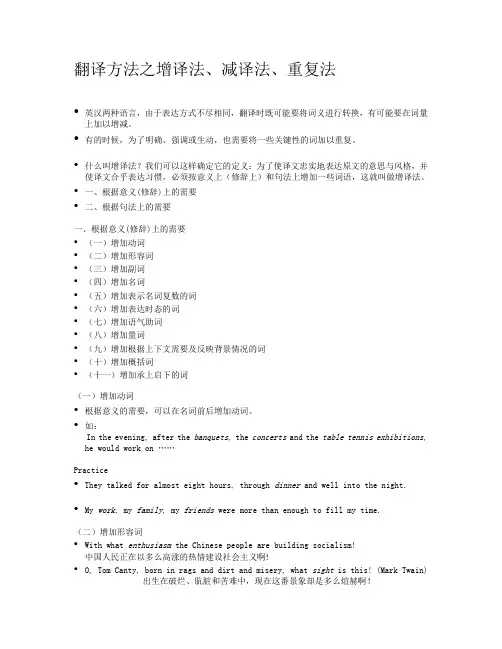
翻译方法之增译法、减译法、重复法•英汉两种语言,由于表达方式不尽相同,翻译时既可能要将词义进行转换,有可能要在词量上加以增减。
•有的时候,为了明确、强调或生动,也需要将一些关键性的词加以重复。
•什么叫增译法?我们可以这样确定它的定义:为了使译文忠实地表达原文的意思与风格,并使译文合乎表达习惯,必须按意义上(修辞上)和句法上增加一些词语,这就叫做增译法。
•一、根据意义(修辞)上的需要•二、根据句法上的需要一、根据意义(修辞)上的需要•(一)增加动词•(二)增加形容词•(三)增加副词•(四)增加名词•(五)增加表示名词复数的词•(六)增加表达时态的词•(七)增加语气助词•(八)增加量词•(九)增加根据上下文需要及反映背景情况的词•(十)增加概括词•(十一)增加承上启下的词(一)增加动词•根据意义的需要,可以在名词前后增加动词。
•如:In the evening, after the banquets, the concerts and the table tennis exhibitions, he would work on ……Practice•They talked for almost eight hours, through dinner and well into the night. •My work, my family, my friends were more than enough to fill my time.(二)增加形容词•With what enthusiasm the Chinese people are building socialism!中国人民正在以多么高涨的热情建设社会主义啊!•O, Tom Canty, born in rags and dirt and misery, what sight is this! (Mark Twain) 出生在破烂、肮脏和苦难中,现在这番景象却是多么煊赫啊!Practice•With the meeting to begin in hours, I hadn’t have time to worry about such trifles.我没有闲功夫为这些琐事操心。
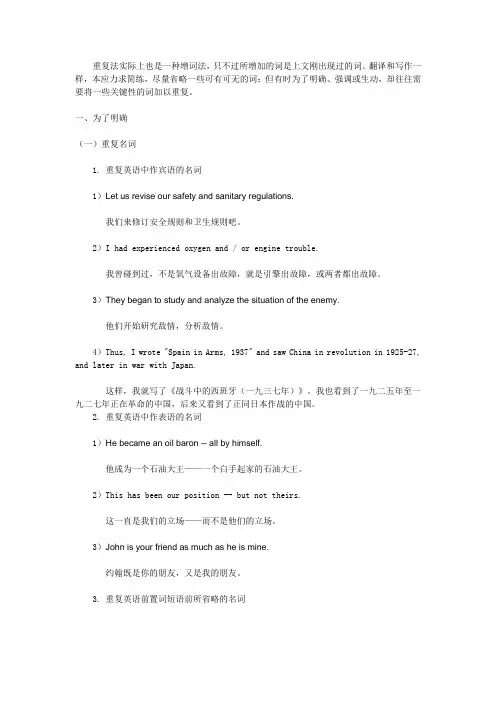
重复法实际上也是一种增词法,只不过所增加的词是上文刚出现过的词。
翻译和写作一样,本应力求简练,尽量省略一些可有可无的词;但有时为了明确、强调或生动,却往往需要将一些关键性的词加以重复。
一、为了明确(一)重复名词1. 重复英语中作宾语的名词1)Let us revise our safety and sanitary regulations.我们来修订安全规则和卫生规则吧。
2)I had experienced oxygen and / or engine trouble.我曾碰到过,不是氧气设备出故障,就是引擎出故障,或两者都出故障。
3)They began to study and analyze the situation of the enemy.他们开始研究敌情,分析敌情。
4)Thus, I wrote "Spain in Arms, 1937" and saw China in revolution in 1925-27, and later in war with Japan.这样,我就写了《战斗中的西班牙(一九三七年)》。
我也看到了一九二五年至一九二七年正在革命的中国,后来又看到了正同日本作战的中国。
2. 重复英语中作表语的名词1)He became an oil baron -- all by himself.他成为一个石油大王——一个白手起家的石油大王。
2)This has been our position -- but not theirs.这一直是我们的立场——而不是他们的立场。
3)John is your friend as much as he is mine.约翰既是你的朋友,又是我的朋友。
3. 重复英语前置词短语前所省略的名词英语中常重复使用前置词,而将第二个、第三个前置词前的名词省略,翻译时则往往要把此名词重复。
1)The doctor will get more practice out of me than out of seventeen hundred ordinary patients.医生从我身上得到的实践,会比从1700个普通病人身上得到的实践还多。
翻译常用的八种技巧1.增译法、增词法:amplification2.重译法、重复法:repetition3.省译法、减词法:omission4.词性转换法、词类转移法:conversion5.正说反译、反说正译法:negation6.语态变换法:the change of the voices7.分译法、分句法(OPP:合句法):division8.语序调整法、词序调整法(顺序法与逆序法)inversion增词法译文中添加一些原文没有的词句,表面上看似不忠实于原文,但仔细分析就会发现这些增加的词句所表达的意思并非无中生有,而是隐含在原文中的。
要知道,从一种语言文字向另一种语言文字转换,有时可以找到一种语言文字在另一种语言文字中的对等词,然而要想全部依赖对等词的转换来达到翻译的目的是几乎不可能的。
不同语言文字所持有的习惯决定了必须根据其中一种语言文字的习惯来适当地增词(或减词)达到语言交际的目的。
如果机械地按照字面意义直译,不仅不能表达原文的思想,精神与形象,而且还会使译文前后矛盾,闹出笑话。
例1 听到你平安的消息,非常高兴!译文: I was very glad on hearing that you were in safety!例2对不起,打扰一下!译文: Excuse me for interrupting you!(增补作宾语的代词you)例3 Histories make men wise; poems witty; the mathematics subtle; natural philosophy deep; moral grave; logic and rhetoric able to contend.译文:读史使人明智,读诗使人灵秀,数学使人周密,科学使人深刻,伦理使人庄重,逻辑修辞之学使人善辩。
(译文中添补了谓语和宾语:增词法;重译法)例4:We won’t retreat, we never have and never will.译文:我们不后退,我们从来没有后退过,我们将来也绝不后退。
英汉翻译重复发转汉语有个明显的特点,也是英语所少见的,就是同义词语的重复。
这种重复在汉语修辞上称为反复,为的是突出某个意思,强调某种感情,以加强读者的印象。
但是在许多情况下,并非出自修辞需要,而是语言本身所固有的。
在翻译中,有时为了忠实于原文,不得不重复某些词语,否则就不能忠实地表达原文意思。
这种反复使用某些词语的翻译方法就叫重复法。
一般说来,重复法有三个作用:一是为了明确,二是为了强调,三是为了生动。
1.名词的重复(1)重复作宾语的名词1)We should learn how to analyze and solve problems.我们应学会如何分析问题、解决问题。
2)A good play serves to educate and inspire the people.一出好戏足以教育人民、鼓舞人民。
3)I had experienced oxygen and/or engine trouble.我曾碰到过,不是氧气设备出故障,就是引擎出故障,或两者都出故障。
4)It is o1)Work while you work,play while you play.该工作时就工作,该玩时就玩。
2)It is impossible to live in society and be independent of society.生于社会,不能脱离社会。
3)Dead is the monarch,dead the servant who cringed beforehim,dead the city in which they dwelt.君主死了,在他面前卑躬屈膝、阿谀奉承的侍臣死了,他们居住的这个都城也死了。
ur duty to rebuild and defend our homeland.重建家园和保卫家园是我们的职责。
2)重复作表语的名词1)Every single woman Iever know is apuzzle to me,as,I have no doubt,she is to herself.我所认识的每一个女人对我来说都是一个谜,而且我毫不怀疑,她自己对她本人也是一个谜。
2.十种翻译技巧了解完四种翻译方法后,我们再来了解一下十种常用翻译技巧,即重复法(repetition),增词法(amplification),省略法(omission),词类转换法(conversion),词序调整法(inversion),拆译法(division),正说反译和反说正译法(negation),语态变换法(voice changes),引申法和句子成分转译法。
2.2.1重复法(repetition)重复法(repetition)是在翻译中,为了使译文忠实于原文并且产生意义明确,文字通顺、流畅,符合目的语习惯的文字,而将某一部分文字反复使用的翻译技巧。
例子:1. You must ask the mother at home, the children in the street, the ordinary manin the market and look at their mouth, how they speak, and translate that way; then they’ll understand and see that you’re speaking to th em in German. (重复谓语动词)你一定要问一问家庭主妇们,问一问街头玩耍的孩子,问一问集市上做买卖的百姓,听听他们说些什么,他们如何说,你就如何译;这样他们就会理解,就会明白:你是在用德语和他们讲话。
2. We have to analyze and solve problems. (重复宾语)我们必须分析问题,解决问题。
3. Ignorance is the mother of fear as well as of admiration. (重复省略的部分) 无知是畏惧之源,羡慕之根。
4. But we still have defects, and very big ones. (指代内容的重复)但我们仍有不足,而且是很大的不足。